View in other NatureServe Network Field Guides
NatureServe
Montana
Utah
Wyoming
Idaho
Wisconsin
British Columbia
South Carolina
Yukon
California
New York
Barr's Milkvetch - Astragalus barrii
State Rank Reason (see State Rank above)
Barr's Milkvetch is endemic to southwestern South Dakota, northeastern Wyoming, Nebraska and southeastern Montana. In Montana, it is known from numerous watersheds, several of which contain large, expansive populations. The habitat occupied by this species is not typically suitable for grazing, and the location of its habitat makes it less vulnerable to all but large-scale developments. Proposed resource extraction in southeast Montana may eventually impact the species. Invasive weeds have the potential to be a threat but currently are not posing problems to the species.
- Details on Status Ranking and Review
Population Size
Score1 - Moderate: Generally 10,000-100,000 individuals.
Range Extent
Score2 - Regional or State Endemic or Small Montana Range: Generally restricted to an area <100,000 sq. miles (equivalent to 2/3 the size of Montana or less) or Montana contributes 50% or more of the species’ range or populations OR limited to 2-3 Sub-basins in Montana.
Area of Occupancy
Score0 - High: Occurs in >25 Subwatersheds (6th Code HUC’s).
Environmental Specificity
Score1 - Moderate: Species is restricted to a specific habitat that is more widely distributed or to several restricted habitats and is typically dependent upon relatively unaltered, good-quality habitat (C Values of 5-7).
Trends
Score0-2 - Stable to Moderate Declines:
CommentDeclines in populations have been observed at some sites particularly following drought years though it is unknown if these are simply cyclical fluctuations or have resulted in longer-term downward trends. More comprehensive monitoring data are needed.
Threats
Score1 - Medium: 11-30% of the populations are being negatively impacted or are likely to be impacted by one or more activities or agents, which are expected to result in decreased populations and/or habitat quality and/or quantity.
CommentResource development in several drainages may impact some populations and associated habitat. Weed invasion has also been identified as threat to some populations.
Intrinsic Vulnerability
Score1 - Moderate Vulnerability: Specific biological attributes, unusual life history characteristics or limited reproductive potential makes the species susceptible to extirpation from stochastic events or other adverse impacts to its habitat and slow to recover.
Raw Conservation Status Score
Score
6 to 8 total points scored out of a possible 19.
General Description
Barr's Milkvetch is a perennial that grows in low, dense mats. Leaves have 3 narrowly lance-shaped leaflets and are 1-4 cm long, densely covered with short white hairs. Stipules at the leaf bases are membranous. Purple or pinkish-purple flowers that are shaped like pea flowers are borne in a narrow, open, few-flowered inflorescence. The petals are 7-17 mm long. The calyx is 3-5 mm long and densely covered with long, white hairs. The sparsely white, hairy pod is narrowly elliptical, 4-8 mm long, and 1-2 mm in diameter.
Phenology
In Montana, Barr's milkvetch blooms from late April to mid-June and forms pods in late May and June.
Diagnostic Characteristics
Barr's milkvetch is distinguished by its small, iridescent, bluish-purple to bluish-pink, early-blooming flowers. Petal color may fade, sometimes to yellowish-white, as flowers dry (Taylor and Caners 2002). Flowers are necessary to distinguish A. barrii from four other matt-forming, 3-leafleted Astragalus species that overlap geographically with it in Montana: A. aretioides (Sweetwater milkvetch), A. sericoleucus (silky milkvetch), A. gilviflorus (plains milkvetch) and A. hyalinus (summer milkvetch).
Flowers or their remnants are necessary to distinguish Barr's milkvetch from co-occurring species of Astragalus that have compound leaves with three leaflets and a cushion-forming habit. The flowers of A. aretioides (Sweetwater milkvetch) and A. sericoleucus (silky milkvetch) are typically one-half the size of A. barrii, and the plants tend to grow in denser mats. A. gilviflorus (plains milkvetch) and A. hyalinus (summer milkvetch) typically have larger, cream to whitish flowers, a longer calyx tube (6-16 mm), and shorter peduncles (0-3.5 mm).
Species Range
Montana Range
Range Descriptions
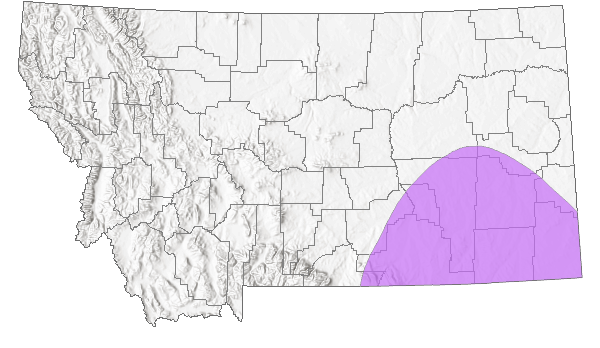
 Native
Native
Range Comments
Regional endemic, known from the southwestern South Dakota, northeastern Wyoming, southeastern Montana and Nebraska.
Observations in Montana Natural Heritage Program Database
Number of Observations: 218
(Click on the following maps and charts to see full sized version)
Map Help and Descriptions
Relative Density
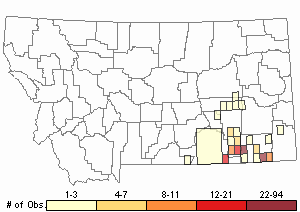
Recency
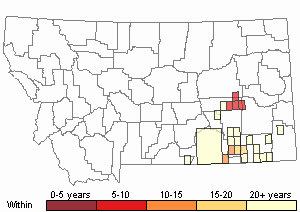
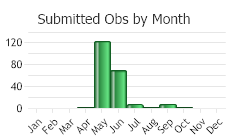
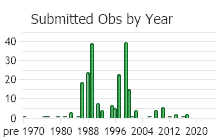
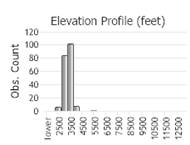 (Observations spanning multiple months or years are excluded from time charts)
(Observations spanning multiple months or years are excluded from time charts)
Habitat
In Montana, Barr's milkvetch occurs on sparsely vegetated knobs and buttes, usually with dry, fine-textured, often calcareous soils (Vanderhorst et al. 1998). These habitats are characterized by a scattered ponderosa pine and Rocky Mountain juniper, or often just a sparse shrub cover of big sagebrush (Artemisia tridentata) and/or shadscale (Atriplex confertifolia). In southeastern Montana, common dominants or associates are western wheatgrass (Pascopyrum smithii or Agropyron smithii), thickspike wheatgrass (Elymus lanceolatus or Agropyron dasystachyum), green needlegrass (Nassella viridula or Stipa viridula), little bluestem (Schizachyrium scoparium), bluebunch wheatgrass (Pseudoroegneria spicata or Agropyron spicatum), prairie junegrass (Koeleria macrantha or Koeleria cristata), native legumes, Nuttall's saltbush (Atriplex gardneri) and winterfat (Krascheninnikovia lanata or Ceratoides lanata) (Heidel & Marriott 1996).
Ecological Systems Associated with this Species
- Commonly Associated with these Ecological Systems
Sparse and Barren Systems
- Occasionally Associated with these Ecological Systems
Forest and Woodland Systems
Shrubland, Steppe and Savanna Systems
Ecology
Barr's milkvetch is associated with the harsh edaphic and environmental conditions of Badlands areas (Heidel and Marriott 1996). These habitats receive limited rainfall and are subject to high light intensities, potentially limiting plant establishment and survival as a result of high soil water evaporation. Barr's milkvetch often occurs on barren, eroded microsites, and may depend on the climate that maintains these sites to limit competition from other species. At some locations, particularly on steep slopes, soils erode during intense rainstorms. However, because of its cushion habit and dense foliage, the soil beneath Barr's milkvetch plants is protected from this erosion, resulting in plants that are frequently perched atop small pedestals of soil (Heidel and Marriott 1996). This species may remain in a vegetative condition under stressful conditions.
Drought conditions in 1987 and 1988 resulted in large decreases in the species' abundance, especially at lower elevations, in lower precipitation zones and on more exposed sites (Heidel and Marriott 1996). This may be a common cyclical trend. It does, however, indicate that populations may respond negatively to a long-term warmer, dryer climatic shift.
Populations in the Custer National Forest occur in habitats that receive more moisture than in surrounding areas and are thus more successionally advanced (Schassberger 1990). In these areas, mats of Barr's milkvetch have been noted as larger and often vegetative. This may reflect a different age-class distribution, with these populations consisting of larger, older mats that have lower rates of flowering and fruiting, and reduced seedling establishment.
POLLINATORS The following animal species have been reported as pollinators of this plant species or its genus where their geographic ranges overlap:
Bombus vagans,
Bombus appositus,
Bombus auricomus,
Bombus bifarius,
Bombus borealis,
Bombus centralis,
Bombus fervidus,
Bombus flavifrons,
Bombus huntii,
Bombus mixtus,
Bombus nevadensis,
Bombus rufocinctus,
Bombus ternarius,
Bombus terricola,
Bombus occidentalis,
Bombus pensylvanicus,
Bombus griseocollis, and
Bombus insularis (Macior 1974, Thorp et al. 1983, Mayer et al. 2000, Colla and Dumesh 2010, Wilson et al. 2010, Koch et al. 2012, Miller-Struttmann and Galen 2014, Williams et al. 2014).
Management
Based on its low, tufted growth form, early-season flowering, and frequent occurrence on secondary range, Barr's milkvetch is probably not affected very much by grazing, unless livestock developments are placed near populations. This species occupies high knobs and outcrops that are seldom selected as development sites. However these habitats could be vulnerable to large-scale disruption of native vegetation and competition from invasives plants, such as yellow sweetclover (Melilotus officinalis).
Stewardship Responsibility
Threats or Limiting Factors
STATE THREAT SCORE REASON
Reported threats to Montana's populations of Barr's Milkvetch include minor impacts from existing weed populations and livestock trampling and grazing. Most of the existing populations occur in the vicinity of coal and methane gas development, where the potential for land surface disturbance to directly impact and subsequently exacerbate threats from invasive plants and livestock is an ongoing concern (MTNHP Threat Assessment 2021).
References
- Literature Cited AboveLegend:
 View Online Publication
View Online Publication Colla, S.R. and S. Dumesh. 2010. The bumble bees of southern Ontario: notes on natural history and distribution. Journal of the Entomological Society of Ontario 141:39-68.
Colla, S.R. and S. Dumesh. 2010. The bumble bees of southern Ontario: notes on natural history and distribution. Journal of the Entomological Society of Ontario 141:39-68. Koch, J., J. Strange, and P. Williams. 2012. Bumble bees of the western United States. Washington, DC: USDA Forest Service, Pollinator Partnership. 143 p.
Koch, J., J. Strange, and P. Williams. 2012. Bumble bees of the western United States. Washington, DC: USDA Forest Service, Pollinator Partnership. 143 p. Macior, L.M. 1974. Pollination ecology of the Front Range of the Colorado Rocky Mountains. Melanderia 15: 1-59.
Macior, L.M. 1974. Pollination ecology of the Front Range of the Colorado Rocky Mountains. Melanderia 15: 1-59. Mayer, D.F., E.R. Miliczky, B.F. Finnigan, and C.A. Johnson. 2000. The bee fauna (Hymenoptera: Apoidea) of southeastern Washington. Journal of the Entomological Society of British Columbia 97: 25-31.
Mayer, D.F., E.R. Miliczky, B.F. Finnigan, and C.A. Johnson. 2000. The bee fauna (Hymenoptera: Apoidea) of southeastern Washington. Journal of the Entomological Society of British Columbia 97: 25-31. Miller-Struttmann, N.E. and C. Galen. 2014. High-altitude multi-taskers: bumble bee food plant use broadens along an altitudinal productivity gradient. Oecologia 176:1033-1045.
Miller-Struttmann, N.E. and C. Galen. 2014. High-altitude multi-taskers: bumble bee food plant use broadens along an altitudinal productivity gradient. Oecologia 176:1033-1045. MTNHP Threat Assessment. 2021. State Threat Score Assignment and Assessment of Reported Threats from 2006 to 2021 for State-listed Vascular Plants. Botany Program, Montana Natural Heritage Program, Helena, Montana.
MTNHP Threat Assessment. 2021. State Threat Score Assignment and Assessment of Reported Threats from 2006 to 2021 for State-listed Vascular Plants. Botany Program, Montana Natural Heritage Program, Helena, Montana. Thorp, R.W., D.S. Horning, and L.L. Dunning. 1983. Bumble bees and cuckoo bumble bees of California (Hymenoptera: Apidae). Bulletin of the California Insect Survey 23:1-79.
Thorp, R.W., D.S. Horning, and L.L. Dunning. 1983. Bumble bees and cuckoo bumble bees of California (Hymenoptera: Apidae). Bulletin of the California Insect Survey 23:1-79. Williams, P., R. Thorp, L. Richardson, and S. Colla. 2014. Bumble Bees of North America. Princeton, NJ: Princeton University Press. 208 p.
Williams, P., R. Thorp, L. Richardson, and S. Colla. 2014. Bumble Bees of North America. Princeton, NJ: Princeton University Press. 208 p. Wilson, J.S., L.E. Wilson, L.D. Loftis, and T. Griswold. 2010. The montane bee fauna of north central Washington, USA, with floral associations. Western North American Naturalist 70(2): 198-207.
Wilson, J.S., L.E. Wilson, L.D. Loftis, and T. Griswold. 2010. The montane bee fauna of north central Washington, USA, with floral associations. Western North American Naturalist 70(2): 198-207.
- Additional ReferencesLegend:
 View Online Publication
View Online Publication
Do you know of a citation we're missing? Barneby, R. C. 1956. Pugillus Astragalorum XIX: Notes On A. Sericoleucus Gray and Its Immediate Relatives. Amer. Midl. Nat. 55: 504-507.
Barneby, R. C. 1956. Pugillus Astragalorum XIX: Notes On A. Sericoleucus Gray and Its Immediate Relatives. Amer. Midl. Nat. 55: 504-507. Barneby, R.C. 1964. Atlas of North American Astragalus. 2 Vols. New York Botanical Garden, Bronx, New York. 1188 pp.
Barneby, R.C. 1964. Atlas of North American Astragalus. 2 Vols. New York Botanical Garden, Bronx, New York. 1188 pp. Fritzen, D.E. 1995. Ecology and behavior of Mule Deer on the Rosebud Coal Mine, Montana. Ph.D. Dissertation. Bozeman, MT: Montana State University. 143 p.
Fritzen, D.E. 1995. Ecology and behavior of Mule Deer on the Rosebud Coal Mine, Montana. Ph.D. Dissertation. Bozeman, MT: Montana State University. 143 p. Heidel, B.L. and H. Marriott. 1996. Sensitive plant species survey of the Ashland District, Custer National Forest, Powder River and Rosebud Counties, Montana. Unpublished report to the U.S. Forest Service. Montana Natural Heritage Program, Helena, Montana. 94 pp. plus appendices.
Heidel, B.L. and H. Marriott. 1996. Sensitive plant species survey of the Ashland District, Custer National Forest, Powder River and Rosebud Counties, Montana. Unpublished report to the U.S. Forest Service. Montana Natural Heritage Program, Helena, Montana. 94 pp. plus appendices. Lesica, P., M.T. Lavin, and P.F. Stickney. 2012. Manual of Montana Vascular Plants. Fort Worth, TX: BRIT Press. viii + 771 p.
Lesica, P., M.T. Lavin, and P.F. Stickney. 2012. Manual of Montana Vascular Plants. Fort Worth, TX: BRIT Press. viii + 771 p. Lesica, P., M.T. Lavin, and P.F. Stickney. 2022. Manual of Montana Vascular Plants, Second Edition. Fort Worth, TX: BRIT Press. viii + 779 p.
Lesica, P., M.T. Lavin, and P.F. Stickney. 2022. Manual of Montana Vascular Plants, Second Edition. Fort Worth, TX: BRIT Press. viii + 779 p. Schassberger, L.A. 1988. Status review of Astragalus barrii, USDA Forest Service, Region 1, Custer National Forest. Unpublished report. Montana Natural Heritage Program, Helena, MT 61 pp.
Schassberger, L.A. 1988. Status review of Astragalus barrii, USDA Forest Service, Region 1, Custer National Forest. Unpublished report. Montana Natural Heritage Program, Helena, MT 61 pp. Schassberger, L.A. 1990. Report on the conservation status of Astragalus barrii: a candidate threatened species. Montana Natural Heritage Program. Helena, MT. 86 PP.
Schassberger, L.A. 1990. Report on the conservation status of Astragalus barrii: a candidate threatened species. Montana Natural Heritage Program. Helena, MT. 86 PP. Taylor, A. and R. Caners. 2002. Baseline Survey for Astragalus barrii Barneby (Barr's milkvetch) and Physaria didymocarpa var. lanata A. Nels. (woolly twinpod) in eastern Big Horn and southwestern Rosebud Counties, Montana. Montana Natural Heritage Program, Helena, Montana. 27 pp.
Taylor, A. and R. Caners. 2002. Baseline Survey for Astragalus barrii Barneby (Barr's milkvetch) and Physaria didymocarpa var. lanata A. Nels. (woolly twinpod) in eastern Big Horn and southwestern Rosebud Counties, Montana. Montana Natural Heritage Program, Helena, Montana. 27 pp. Vanderhorst, J.P., S.V. Cooper, and B.L. Heidel. 1998. Botanical and vegetation survey of Carter County, Montana. Unpublished report prepared for the Bureau of Land Management. Montana Natural Heritage Program, Helena. 116 pp. + app.
Vanderhorst, J.P., S.V. Cooper, and B.L. Heidel. 1998. Botanical and vegetation survey of Carter County, Montana. Unpublished report prepared for the Bureau of Land Management. Montana Natural Heritage Program, Helena. 116 pp. + app.
- Web Search Engines for Articles on "Barr's Milkvetch"





